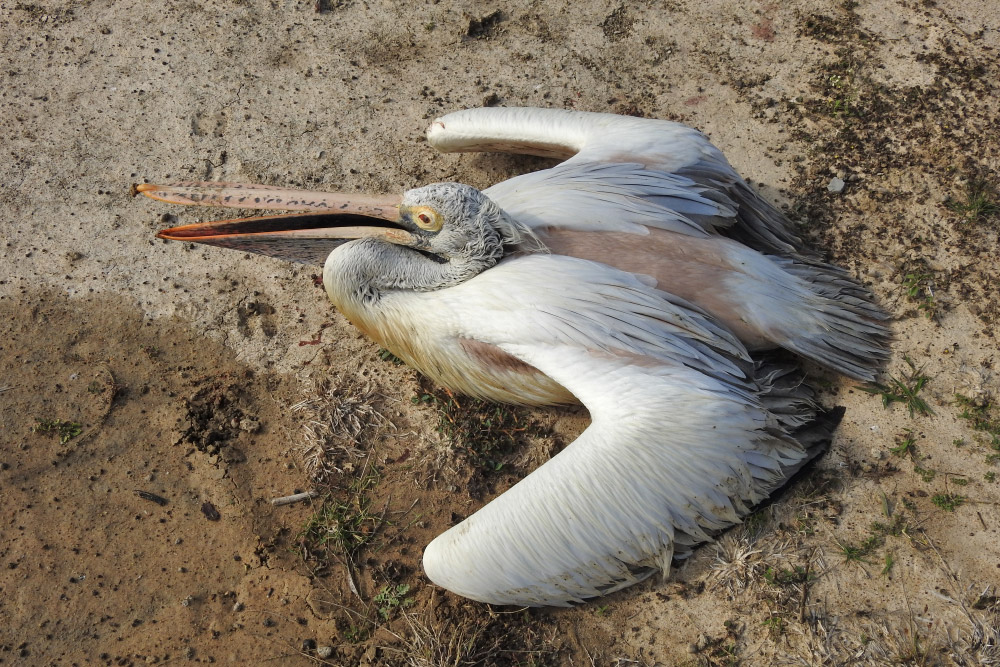On the morning of December 20, 2020, when international birders Mike Prince and Chris Bowden visited Sonnapura Lake near Chikkaballapur Town, about 23 km from Bengaluru, they were not prepared for what they found along the water’s edge — two dead Spot-billed Pelicans (Pelecanus philippensis). Subsequent visits to the lake resulted in the matter being brought to the attention of the Karnataka Forest Department, which promptly despatched the dead birds to the Bannerghatta Zoo on the outskirts of Bengaluru for a post mortem. Autopsies revealed that the alimentary canals of the birds were packed with endoparasitic nematodes. More dead pelican were discovered at the lake during further visits.
Spot-billed Pelicans are one of the most threatened (listed as Near Threatened in the IUCN Red List) of the seven species of pelicans in the world. In India, they are listed in Schedule IV of the Wildlife (Protection) Act, 1972 (WPA).
If this was thought to be an isolated case, it was not to be. The nematode infestation in pelicans was nothing new. Between 2017-18, a total of 67 Spot-billed Pelicans died in five waterbodies that included 55 in Kokkare Bellur Community Reserve near Maddur, seven in Kukkarahalli tank in Mysuru, three birds in Sulekere and one each in Madarahalli near Maddur and Malavalli, all in Mandya district of Karnataka. All the birds that died in different waterbodies were adults (Kumar et al. 2019). In December 2015, four sick birds were rescued at Jakkur Lake in Bangalore and were shifted to the care of People for Animals facility in Bangalore, where two birds died and showed nematode infestation. Two others that were dewormed and cared for recovered eventually. Similarly, the cause for the death of Spot-billed Pelicans in Andhra Pradesh was attributed to endoparasitic nematodes (Sreedevi et al. 2017), as also in Assam (Islam and Talukdar 2009) and Tamil Nadu (Pazhanivel et al. 2017). These deaths are quite possibly due to the infestation of Nematode and Trematode parasites, quite possibly Contracaecum, Echinostoma and Opisthorchis species. All the three species were found in the dead birds at Kokkare Bellur and a large proportion of Contracaecum sp. were found in proventriculus and gizzard and Echinostoma sp. were found in the intestine of the dead birds at Kokkare Bellur (Kumar et al. 2019). About six dead pelicans were recorded at Kokkare Bellur during December 2020 and the post mortem of a few birds revealed the presence of nematodes.
The eggs of these parasites enter the water through the faecal shedding of the definitive host: usually, waterbirds like pelicans. The second-stage larva hatches out from the egg in the water with a larval sheath, which is then ingested by the primary intermediate hosts, copepods. These parasite larvae shed their sheaths in the intestine of the copepod, and then grow in the body cavity. When the copepods are eaten by the secondary intermediate host – fish, the larvae develop into third-stage larvae in the abdominal cavity. When these fish are eaten by the definitive hosts like the pelicans, the third-stage larva grows and moults twice to develop into an adult worm. After fertilization, the female starts laying eggs, which pass through the faeces into water, thus completing the life cycle (Kumara et al. 2019). To derive sustenance, the worms bore through and latch on to the inner wall of the alimentary canal of their hosts. Many suspect that nematodes may not, however, be the primary cause of death of all these pelicans. The nematode infestation appears to pre-dispose the birds to become weak and then starve, unable to-ingest food. As the infestation intensifies, the gizzard and proventriculus get clogged by high nematode loads, blocking the intestinal passage. This further leads to starvation and, eventually, death. In November 2018, about 50-60 Cormorants were found dead at the Kesavanahalli Lake in Bengaluru (Anon 2018), but it is not known if these deaths were also caused due to high nematode loads in them.
At present, these deaths involving nematodes appear to be restricted to Pelicans. With fish being a secondary intermediate host, these nematodes may well be geared-up to infest all fish-eating birds. If this happens, it could well be a beginning of a crisis where all our fish-eating birds could be under threat and may go the way of the vultures, by way of mass-deaths. At present, there appears to be very little that one can do if these parasite infestations becomes rampant. However, the death of these pelicans has thrown-up many more questions as to the involvement of other causal factors that could be killing these birds, besides the nematodes infestation.
References:
- Anonymous 2018. Cormorants die in lake; causes concern among environmentalists.
- Kumar S., Periyasamy A., Ranga Rao N.V., Sunil S.S., Kumara .HN., Sundararaj P., Chidananda G., and Sathish A. 2019. Multiple infestations of gastrointestinal parasites – Probable cause for high mortality of Spot-billed Pelican (Pelecanus philippensis) at Kokrebellur Community Reserve, India. Int. J. Parasitol Parasites Wildl. 9: 68-73. doi: 10.1016/j.ijppaw.2019.04.001. PMID: 31011528; PMCID: PMC6463544.
- Pazhanivel, N., Kumar, V., Gopal, K., Anna, T., Thangathurai, R. and Balachandran, C. 2017. Pathology of Contracaecum Sp. infection in Spot-billed Pelican (Pelecanus philippensis). Indian Veterinary Journal, 94:76 – 77.
- Sreedevi, C., Prasuna, K., Lavanya, K.K. and Swarnalatha, K. 2017. Contracaecum Rudolphii Hartwich 1964- (Nematoda: Anisakidae) in a wild Spot-billed Pelican (Pelecanus Philippensis): A case report. Journal of Parasitology Diseases, 41: 959-962,
- Talukdar, B.K. 1999. The status of Spot-billed Pelican in Assam, India. Oriental Bird Club Bulletin, 30:13-14.


 CI is a non-profit, non-commercial portal that aims to facilitate wildlife and nature conservation by providing reliable information and the tools needed to campaign effectively.
CI is a non-profit, non-commercial portal that aims to facilitate wildlife and nature conservation by providing reliable information and the tools needed to campaign effectively.


